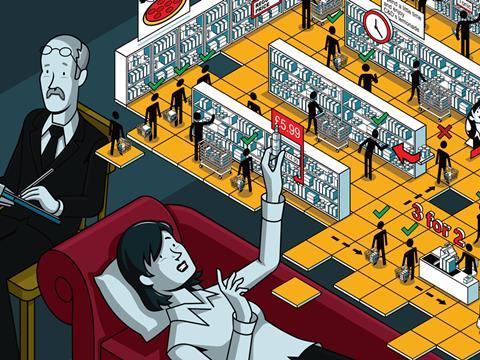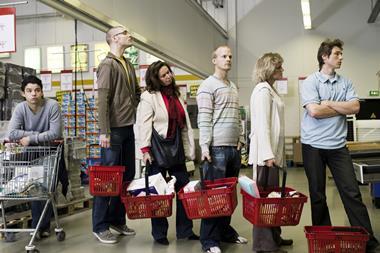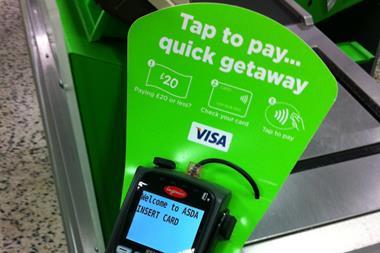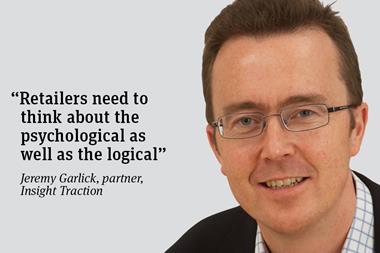
Multibuy mind games
The tool of choice for supermarkets keen to drive up volume sales on a SKU, multibuys work at their best with a touch of psychological knowhow. Shoppers instinctively read left to right, top to bottom, and anchor on the first thing they read, says Phillip Adcock, managing director at SBXL. An offer that reads ‘£1.80 each, or 3 for £4’ will tempt a consumer to opt for less than if the promotional ticket is flipped to read ‘3 for £4, or £1.80 each’. In fact tests have shown the average rate of purchase for the latter is 1.7 compared with 1.3 for the former.
Painless payments
Parting with hard-earned cash can be a painful (if necessary) experience. Numb that pain and consumers are far more willing to top up their trolleys, according to marketer Nick Kolenda. For grocers it can be as simple as removing the ‘£’ sign from a price ticket, or ditching all mention of money in product descriptions. In one experiment, twice as many shoppers bought lemonade sold with the slogan ‘Spend a little time and enjoy C&D’s lemonade’ compared with ‘Spend a little money and enjoy C&D’s lemonade’.
Sheepish shoppers
Forget individualism, food shopping is all about following the crowd and fitting in with the faceless pack, say experts. Cynics need look no further than recent results from an experiment at an Essex shopping mall.
Psychologists hung one poster of a lone woman tucking into a burger outside Lakeside food court under a strapline encouraging shoppers to have lunch early.
The poster worked: that day 25% more customers than usual grabbed a bite to eat before 12 noon, says Kinetic, the out-of-home media specialist behind the test.
However, by simply swapping the single woman for a shot of a group of friends passing round slices of pizza, footfall rose by a further 75% the next day.
Spotting this group giving into hunger pangs early persuaded social shoppers this would be a permissible and desirable activity, a phenomenon dubbed ‘herding’.
It’s an instinct arising from our ‘Homer Simpson’ (or System 1) brain, says Jennie Sallows, head of insight at Kinetic. It is responsible for the 95% of decisions we make on instinct, or autopilot.
That’s in contrast to the sensible ‘Spock’ - or System 2 - brain, where we think through things more rationally. And it’s the Homer in all of us that the supermarkets should look to engage with their in-store signage, adds Sallows.
Mob mentality “holds massive implications for grocers” she says. “It shows you needn’t be reliant on price.”
Simple changes can make a big difference at driving up average basket spend, she adds.
For example, supermarkets need to clearly communicate to customers what others are buying with descriptions of the ‘most popular’ or ‘bestselling’ products. Or follow the Lakeside example and illustrate aisles with families tucking into products at home.
Product promotions without the price drop
Obsessed with the power of promotion, supermarkets are slashing prices on up to 25% of SKUs at any one time, according to Phillip Adcock. It’s all too much for their poor shoppers to handle. Forced to process up to two promotions per second as they browse the shelves, consumers can’t calculate the best deal and resort to zoning in on products (or promotions) that stand out from the crowd, rendering many discounts meaningless.
“The bottom line is nobody needs to give that much away” as “there is a psychology of special offers that the world is ignoring,” says Adcock. The simple addition of a yellow border around a brand can increase sales by as much as 150%, he says, as consumers instinctively link yellow with money off, whether or not
there’s a discount at all. For instance, sales of full-price Stella were “going through the roof” in one Tesco store, Adcock claims, without the supermarket trying. A little investigation found the trigger factor was a ‘Thieves will be prosecuted’ warning sign pasted behind the lager, with the simple explanation that it made the product stand out from its rivals.
Devious discount(ers)
It’s not only their rivals that Aldi and Lidl have outwitted. Shoppers psychologically conditioned to pair products with the shelf-edge price in front may have found themselves flummoxed by pricing layout at the discounters.
The cost of pricey top-shelf products such as Champagne has been spotted on back wall posters in some stores, says Adcock, with the shelf-edge price below referring to far cheaper SKUs.
Shoppers fooled by the tactic (whether intentional or not) could be in for a nasty shock when they check their receipts.
Smile for sales!
Cavemen had trust issues. Forced to defend their homes from marauding rivals (and sabre-toothed tigers), they quickly learned to distinguish friend from foe at a distance, so strangers stepping on their territory with a smile had a far better chance of escaping intact.
It’s an evolutionary trait still running through 21st-century shoppers. Consumers can recognise a smile from further away than any other emotion, explains Adcock. As a result, the mere sight of a smiling face near a product or a store subconsciously draws us in and gives us warm fuzzy feelings all the way to the till. “It’s all good old-fashioned evolution and survival of the fittest,” he adds.
Alas, nobody thought to mention this to M&S - if the imposing shots of “moody models” in their latest clothing lines are anything to go by. Staring down at shoppers with what looks like thinly veiled contempt, the images will only switch most off from browsing the rails, believes Adock. It may be less fashionable, but a simple smile would go a long way to boosting sales.
Worse still is a striking lack of faces at all in most food stores, he says, where wordy blurbs and price tickets are chosen to shift SKUs instead. A quick lesson in evolution shows how that can be a big mistake. In the history of the human brain images have been around from year dot. Language, on the other hand, has only existed for a mere 7,000 years, and numbers a trifling 4,000.
As a result, language and prices take far longer to process and reflect upon. It also leaves the impact less emotionally engaging than a friendly face. “Faces should be everywhere in stores,” believes Adcock. Eyes in particular hold immediate appeal for women, he adds. That means more faces plastered over product packaging and across stores. “People will look, and when you’ve got their attention you can get on with selling,” he adds.
Aisles trump ends
Brands shelling out thousands for gondola ends are wasting cash. So says shopper psychology experts SBXL, whose hidden cameras found shoppers were more likely to make final decisions in the aisle.
Footage showed 99% of orange juice bought in one store was grabbed from the main aisle, rather than from promotions at the end. Gondola ends only nudge shoppers - who lack knowledge of prices against which to measure a deal - to investigate the full range. So when your rival spends its money on a gondola end, invest heavily in the aisle.
Seducing a new breed of shopper
It hardly needs saying, but shopping habits have changed. Gone is the weekly trawl through each and every supermarket aisle, and with it many of the opportunities for stores to seduce shoppers to go off-list. Much less prone to planning meals in advance, this new breed of promiscuous consumer is more likely to head into stores with a clear shopping ‘mission’ in mind. That doesn’t mean they’re beyond incremental sales seduction, however.
Tesco is at the vanguard of the solution, with its trialling of new occasion-led layouts. By pairing tinned tomatoes with pasta, and candles with cake mixtures at 50 stores, CEO Dave Lewis is leading a new wave of psychological warfare. And rival retailers would do well to follow this example.
Experts estimate shoppers spend no more than 18 seconds deliberating each purchase. By arranging obvious add-ons in easy reach, supermarkets can nudge customers to grab extras before their concentration wavers and they head off on their next mission. It works for brands, too. Pepsi sold 40% more Pepsi Max when they cosied up with Doritos crisps on shelves.



















No comments yet